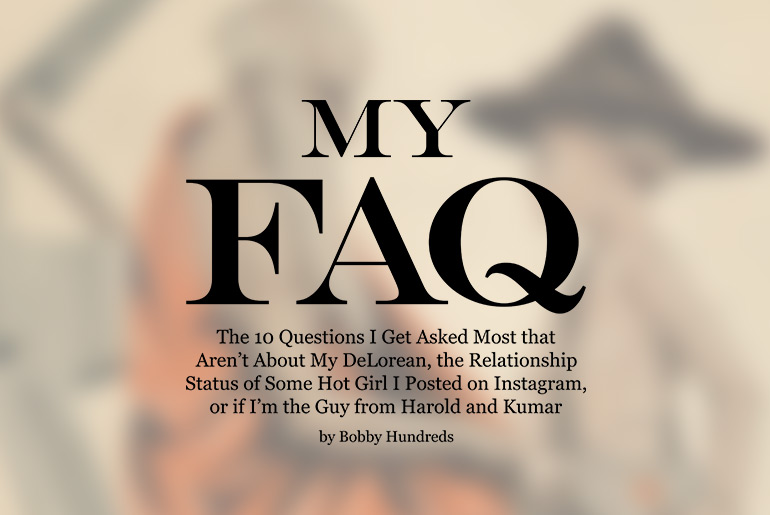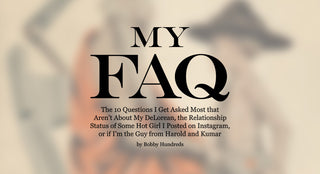
This week alone, I was granted the opportunity to speak at two different colleges (Pitzer and UCLA). The meat of these discussions typically sprouts from the Q & A portion of the night, but after doing this for a decade, I’ve recognized that I often repeat answers to the same questions.
And if these students are wondering the same things, substantiated by the identical tweets and Instagram queries, this probably means that many of you have similar questions as well.
So, here are 10 of the most frequently asked questions of me, as it pertains to The Hundreds, building a brand, and career. Because much of what I do stems from Streetwear, you’ll see a lot of the expected references, but you can really apply this advice to any field, hobby, or industry.
Thanks for always asking good questions.
1. “How did you get your start?”
Ben and I started The Hundreds 12 years ago, at the age of 23, out of my studio apartment. We had no connections, experience, and weren’t backed by celebrities or coolguys. Our families are not involved in this trade. We started the company with literally $600 out of our pockets (We still own The Hundreds today).
The more important question is not “How?,” but, “Why?” We started the brand because we were passionate about Streetwear, street culture, and wanted to express our ideas on T-shirts and in the online magazine.
2. “But, how did you blow up?”
I don’t know if we’ve blown up, but we’ve grown up.
And, that’s come by way of hard work, defining an opinion through strategic branding, being mindful of trends in the marketplace, responding to the status quo, reacting to missteps, and most elusive of all, dumb luck.
I think we’re smart dudes, but that’s not necessarily an advantage in a space where you can easily overthink things. We’re decent businessmen and designers, but there’ve been so many others who were better and didn’t survive. So, it’s not just about skills or education.
We supported our local community by working with shops in our backyard, and exposing friends through our platforms. As our movement resonated around the world, we did our best to sustain friendships. You have to support those who support you, because—Dilated Peoples said it best: “When worst comes to worst, my peoples come first.”
People over product. Truly, we blew up because you gave us a chance.
3. “What was your biggest mistake?”
I’ve made so many mistakes, but I pivoted most as opportunities to be better. It’s hard to hold regrets—I mean, at the time, that choice was what I really wanted.
Success and failure are relative. Bad decisions led to some of the most rewarding brand and business lessons of my life. Even if you make a wrong turn, even if you’re going backwards, you’ve gotta keep moving. Inertia. If you stay in park, the car will die, and you’ll be stuck forever.
There were a lot of relationships I built as an employer or partner—or simply as an industry friend—that I look back on, and shudder. But, even they have helped me to choose better people to surround myself with.
Other than that, maybe a license-plate holder that read, “I’d rather be at The Hundreds,” except the spacing between “be” and “at” could have been wider. It looked like, “I’d rather BEAT The Hundreds.”
4. “What do you say to the haters and the people who doubted you?”
I don’t really do this for anyone’s approval or disapproval. The positive feedback is sweet to hear, but I was designing and storytelling back when my audience was a few stuffed animals and a wall. Same goes for the hate. I listen to some of it, I even agree at times, but it doesn’t affect my vision.
Does it hurt? Sometimes it can really sting, but more from a “Damn, some humans are foul!” point of view. But, I’m not crowdsourcing validation here. I started a brand to stand out, not disappear into popular opinion. My intent wasn’t to make people comfortable, it was to upset their setup.
What do I say to them? “Oh, that’s nice, but I’ve gotta go. I got work to do.”
5. “How do you do a collaboration?”
I never understood this question. I don’t know, man—it’s like putting a puzzle together with a friend. You just do it.
Of course, there are all sorts of puzzles. There are organic projects conceptualized by drinking buddies on a cocktail napkin. There are higher-profile collabs between mega properties that are just straight-up, soulless, licensing deals.
The best kinds are the ones that come together for a reason and a purpose. If there’s a compelling story there, the collaboration will be memorable and edify the brand. Otherwise, it may make a fast buck, but will chip away at your identity.
6. “So, what’s your favorite collaboration?”
This answer changes daily. Today, I could point to Garfield as our ideal collaborative partner. They were cooperative, involved, gave us creative license, and understood the marketing benefits of collaborations over sales. Best of all, Garfield had personal relevance to our brand, as I emulated Jim Davis’ artwork in learning how to draw. It was a great and fun story to tell, and made a lot of sense with our brand as far as art, humor, and personality go.
They are all my favorites for different reasons. Career-wise, it meant a lot to work with adidas. Our collaboration with Disney cemented us as a serious Streetwear contender. G-Shock allowed us the biggest and best The Hundreds party. As far as narratives go, there’s no better story than what led to The Hundreds by Lance Montoya.
7. “Look at my brand. Do you think this will work?”
Probably not.
That doesn’t mean you should stop. In fact, this is exactly why you should keep going. Seriously!
Look, you shouldn’t be out to appease someone like me, or win the industry’s favor. You should be doing everything in your power to piss us off. It shouldn’t be anything we like or have seen. All other brands should feel threatened and confused. Your duty is to respond to what came before, and introduce a new opinion into the space.
Most of the brands that young people bring to my attention are garbage in popular culture’s eye: raw, untrained, and independent of popular trend. But, without all the pretense and perfection, you see the unique heart more visibly. This is what keeps the culture creative, dynamic, and moving forward.
I don’t get it, but someone else will. That’s the guy or girl whose answer you should seek.
8. “Where do you find inspiration?”
Nouns have it right: People. Places. Things.
Learning about people. They are vast oceans of stories, and that’s really what my life’s work is about: storytelling.
Places. There’s no faster way to be squeezed out of your comfort zone than by traveling. When you’re forced to think differently and look at the world anew, you can’t help but change. Sometimes I have to fly halfway around the globe to have an honest and refreshing conversation with myself.
Things—Design and product that others have made and poured themselves into. Whether it’s a coffee mug or a phone app or a pair of washed denim. Be a student always. The universe is your classroom. The creations are the lessons.
9. “Where is Streetwear headed?”
I don’t know, and I don’t really care. I just worry about where I’m headed and let the rest of the industry deal with it.
10. “Any advice for me?”
Sure. Do NOT get into this industry because you think it’s gonna be all fun and games, that it’ll bring you girls or glory, and mostly, that you’re gonna get rich. Like any other business upstart, it’s demanding work and a big drain on your pocketbooks with potentially little reward. I think 90% of most small businesses don’t make it past a year? Many entrepreneurs are artistic visionaries who seem to forget that at the end of the day, it boils down to a job.
Visit trade shows like Agenda, support local shops (even if you sell direct-to-consumer), and surround yourself with other designers, brands, and creative minds who share your passion and drive. You can help each other out and learn from another’s mistakes and successes. It can be a treacherous and lonely road on your own. There’s nothing wrong with making friends and building a team of people who can all get things done together. For me, it’s the best part of the game—the relationships.
Have fun. HAVE FUN. And work hard. WORK HARD. Difficult times lie ahead, but the highs are worth it. The key to success is not superior design or how cool you are. It’s about how hard you want to work. Your success is predicated upon how much of your life you’re willing to devote to the brand.
To us, there is no distinction between work and play. If you’re still interested, jump in. The water’s freezing cold, so we need more bodies to keep us warm.
GOOD LUCK!

